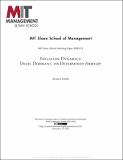Inflation Dynamics: Dead, Dormant, or Determined Abroad?
Author(s)
Forbes, Kristin J
DownloadAccepted version (1.117Mb)
Open Access Policy
Open Access Policy
Creative Commons Attribution-Noncommercial-Share Alike
Terms of use
Metadata
Show full item recordAbstract
© 2019, Brookings Institution Press. All rights reserved. Inflation dynamics have been difficult to explain over the last decade. This paper explores whether a more comprehensive treatment of globalization can help. CPI inflation has become more synchronized around the world since the 2008 crisis, but core and wage inflation have become less synchronized. Global factors (including commodity prices, world slack, exchange rates, and global value chains) are significant drivers of CPI inflation in a cross-section of countries, and their role has increased over the last decade, particularly the role of nonfuel commodity prices. These global factors, however, do less to improve our understanding of core and wage inflation. Key results are robust to using a less-structured trend-cycle decomposition instead of a Phillips curve framework, with the set of global variables more important for understanding the cyclical component of inflation over the last decade but not the underlying slow-moving inflation trend. Domestic slack still plays a role for all the inflation measures, although globalization has caused some “flattening” of this relationship, especially for CPI inflation. Although CPI inflation is increasingly determined abroad, core and wage inflation are still largely domestic processes.
Date issued
2019Department
Sloan School of ManagementJournal
Brookings Papers on Economic Activity
Publisher
Project Muse